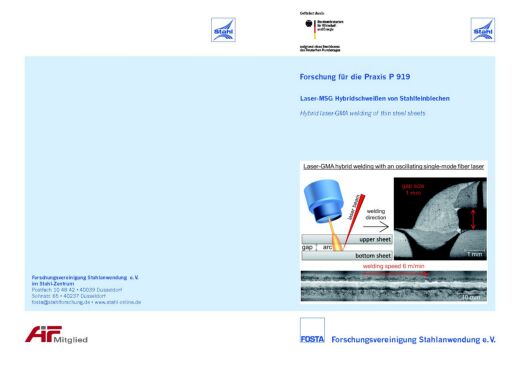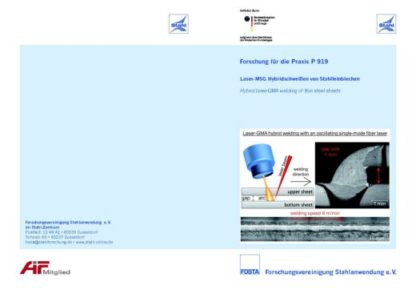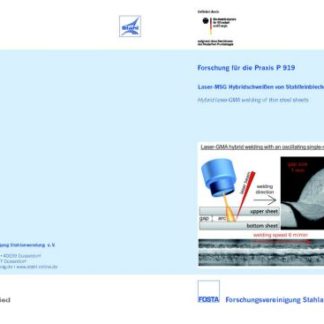Description
P 919 -Hybrid laser-GMA welding of thin steel sheets
Today’s state of technology in terms of welding high strength steel clearly shows that the development of a welding process with low heat input, high gap bridging ability and edge misalignment tolerance is demanded. An intensive investigation of the welding process is needed especially concerning industrial requirements, such as high welding velocities and minimal thermal stresses. Furthermore, the gap and misalignment tolerances of the welding process shall meet the industrial production conditions. The primary disadvantages of laser beam welding are the needs of a very precise joint preparation. However, arc processes like GMA welding are used commonly, in order to tolerate large gaps and edge misalignment, but the thermal impact for the joint is higher. In this study, the advantages of both single processes could be used by combining them to a hybrid process in a synergetic way.
The hybrid welding process designed for the welding of 22MnB5 was carried out with a combination of a single mode fiber laser with a MAG welding process. By use of laser beam oscillation, the laser beam energy input could be governed precisely. Using this configuration, high process reliability and gap tolerances up to 1 mm were achieved. The thermal strain of the steel was reduced by an enhanced welding velocity of 6 m/min. In addition, these welding velocities ensure a particular high efficiency. Laser GMA hybrid welding with reduced heat input can be used beneficially for ultra-high strength steel sheets as well as for combinations of 22MnB5 and zinc coated DP800.
Furthermore, a temperature controlled welding process with an inline temperature measurement and a feedback control was developed. This control uses a new imaging method which is based on pyrometric temperature measurements. This control will be used for ongoing investigations regarding to the reduction of the energy input of welding processes like the laser GMA hybrid welding. In the presented study, the influence of welding parameters on the thermal strain and weld seam characteristics was investigated. Hence, weld seam strength up to 917 MPa were achieved in quasistatic tensile tests.
This project enhances joining quality of presshardened 22MnB5 steel sheet joints. The advantage of this new approach of combining the laser beam and GMA welding are increased welding velocities and hence, a reduced heat input. The steel manufacturer as well as the SME and also large enterprises in the steel application sector will benefit by a safe and efficient use of press-hardened steel in the industrial production.
The research project (IGF-Nr. 16586 N) was carried out at Bremer Institut für angewandte Strahltechnik GmbH (BIAS) und an der FachhochschuleBrandenburg, Maschinenbau Fertigungs-/Produktionstechnik, Fügetechnik. FOSTA has accompanied the research project work and has organized the project funding from the Federal Ministry of Economics and Technology through the AiF as part of the programme for promoting industrial cooperation research (IGF) in accordance with a resolution of the German parliament.
Only available in german language.
Published in:
2015
Authors:
H. Kügler, F. Möller, F. Vollertsen, S. Baum, S.-F. Goecke




